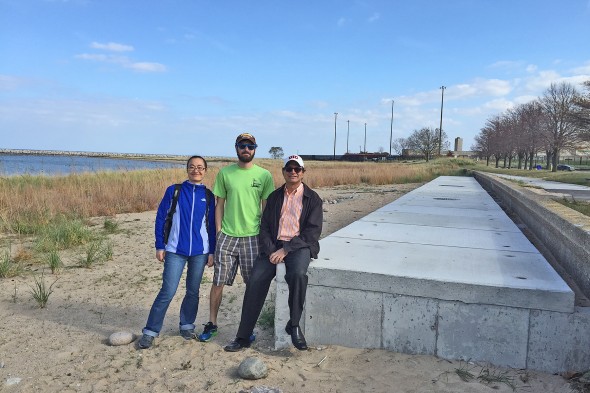UIC researchers help keep Chicago beaches safe for swimming

Engineering professor Krishna Reddy (right) visits the filtration system he designed with research assistants Yuling Yang and Drake Pitynski at Rainbow Beach.
As the sun shines above Rainbow Beach, three UIC researchers step onto a concrete structure bounding the beach and parking lot. They open a handle on top of the concrete and gaze below.
The concrete structure houses a filtration system designed by researchers in Krishna Reddy’s lab to protect the beach from E. coli and other contaminants, such as heavy metals and organic chemicals.
“I was really excited about working on a real problem and making a difference,” said Reddy, professor of civil and environmental engineering.
Reddy received a grant from the U.S. Environmental Protection Agency to create the filter in partnership with Chicago Park District and Illinois Institute of Technology.
“Near shore or beach contamination is a unique urban problem,” Reddy said.
Rainbow Beach was closed more than 100 days because of E. coli contamination from 2010 to 2014, according to the U.S. Environmental Protection Agency. Rainwater carrying bird waste, motor oils and biodegradables contributed to the contamination.
Reddy and his research team began the project by collecting data to confirm the correlation between contamination and rainfall. Once confirmed, they transitioned into designing the filter, one that would capture and neutralize the contaminants.
An urban atmosphere, however, posed its own constraints.
“Out of all filtration prospects, constructing an in-ground filter system maximized space and practicality of the mission in a populated landscape,” Reddy said.
The project was implemented at one of the most frequently contaminated beaches, Rainbow Beach, on 77th Street. Students in Reddy’s lab have helped collect samples to monitor pre-and post-filtration levels of E. coli and other contaminants.
The filtration system will “protect the health and provide recreational opportunities,” Reddy said.
Drake Pitynski, a senior in chemistry, has helped collect the samples at the beach. “I’ve always wanted to help the environment since I was a kid.” Pitynski said. “I’m doing something real.”
The filtration system could be a modern solution to near-shore run-off around the world.
“I hope to see it implemented in other places,” Pitynski said.
